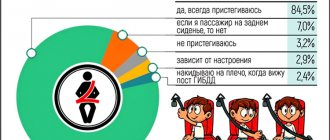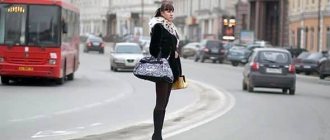Motorists often treat pedestrians with disdain, allowing themselves not to let them pass when it is necessary and provided for by traffic regulations. Considering that pedestrians are road users, a driver may be subject to administrative liability for ignoring their rights. One of the most common situations is when a driver prevents a person from crossing a pedestrian crossing. Let's see what the law says about this and try to answer the question: what fine does a driver face in 2021 if he does not let a pedestrian pass?
What's the fine?
It ranges from 1,500 to 2,500 rubles at the discretion of the inspector and is provided for in Article 12.18 of the Administrative Code.
- If a pedestrian’s failure to pass was recorded on an auto-recording camera, then most likely the maximum fine will be assigned.
- The fine for failure to allow a pedestrian to pass can be paid with a 50 percent discount in the first 20 days from the day the decision was issued (not to be confused with the day it entered into force).
What is required from a motorist
You cannot think that traffic light signals will be the only indication for a car when allowing pedestrians to pass. The rules impose great responsibility on him. So, he must:
- remember that a citizen has priority when passing through the passage. Even if the green light turns on for the car owner, he must wait until the passerby completes his movement completely. This is stated in clause 14.3 of the traffic rules;
- give up the desire to use the horn to speed up a pedestrian. This is considered a violation and is punishable by fines.
All this requires composure and attention from the driver.
The concept of "pedestrian crossing"
First of all, starting a review on a topic such as pedestrian crossings and rules. Which are associated with it, it is worth paying attention to the specification of this term. Namely, today a pedestrian crossing is a place intended for pedestrians to cross the roadway, which can be located in the following places:
- Directly the roadway;
- Tram tracks that can also cross the median;
In the case of tram tracks, all vehicles, both trams and cars, are required to let pedestrians pass, otherwise, vehicle drivers will be issued a fine of 1,500 to 2,500 rubles in 2019-2020.
However, we will warn you that you should not be too confident and thoughtlessly cross the tram tracks, since due to the large mass and speed, the tram may not have time to stop.
The driver had no obligation to give way to the pedestrian
The driver had no obligation to give way to the pedestrian
SOLUTION
Orenburg November 13, 2015
Judge of the Orenburg Regional Court ...., with the secretary ... having considered in open court the complaint ... against the decision of the traffic police inspector of the 2nd company about the traffic police of the State Traffic Safety Inspectorate of the Russian Ministry of Internal Affairs for the Orenburg region No. dated August 05, 2015, the decision of the judge of the Dzerzhinsky District Court of Orenburg dated September 23, 2015 year in a case of an administrative offense under Art. 12.18 Code of Administrative Offenses of the Russian Federation, in relation to...,
installed:
by the resolution of the traffic police inspector of the 2nd company on the traffic police of the State Traffic Safety Inspectorate of the Ministry of Internal Affairs of Russia for the Orenburg region No. dated August 5, 2015, upheld by the decision of the judge of the Dzerzhinsky district court of Orenburg dated September 23, 2015, ... found guilty of committing an administrative offense under Article 12.18 of the Administrative Code RF, and he was given an administrative penalty in the form of an administrative fine in the amount of 1,500 rubles.
In a complaint filed with the Orenburg Regional Court, ... expresses disagreement with bringing him to administrative responsibility, and asks the decision of the judge of the Dzerzhinsky District Court of Orenburg dated September 23, 2015 to be cancelled. Does not agree with the court’s assessment of the evidence and interpretation of the Traffic Rules of the Russian Federation in relation to the circumstances of the case.
Having studied the case materials, the arguments of the complaint, and listened to the official who made the decision in the case of an administrative offense, FULL NAME1, I come to the conclusion that it is necessary to cancel all the above procedural acts issued in the case, for the following reasons.
The basis for bringing ... to administrative liability was a protocol on an administrative offense, according to which ... on August 05, 2015 at 16:16 near (address), driving a car **** state registration plate ***, in violation of paragraph 14.1 of the Traffic Rules of the Russian Federation, approved by Resolution of the Council of Ministers - Government of the Russian Federation of October 23, 1993 No. 1090 (hereinafter referred to as the Traffic Rules), did not provide priority in traffic to a pedestrian crossing the roadway at an unregulated pedestrian crossing.
Bringing ... to administrative liability under Art. 12.18 of the Code of Administrative Offenses of the Russian Federation, the official proceeded from the evidence of violation ... of the requirements of clause 14.1 of the Traffic Rules.
Considering the complaint ... against the official’s decision, the judge of the Dzerzhinsky District Court of Orenburg agreed with the qualification of the applicant’s actions.
At the same time, it is impossible to agree with the conclusions of the official and the judge of the district court due to the following.
Article 12.18 of the Code of Administrative Offenses of the Russian Federation provides for administrative liability for failure to comply with the requirement of the Traffic Rules to give way to pedestrians, cyclists or other road users (except for vehicle drivers) who have priority in traffic.
Clause 14.1 of the Traffic Rules establishes that the driver of a vehicle approaching an unregulated pedestrian crossing is obliged to give way to pedestrians crossing the road or entering the roadway (tram tracks) to cross.
Give way (do not interfere) is a requirement that means that a road user must not start, resume or continue moving, or carry out any maneuver if this may force other road users who have priority over him to change the direction of movement or speed.
An analysis of the above norms allows us to recognize that the requirements specified in them “to let pedestrians pass” and “to give way to pedestrians” are equivalent.
By virtue of clause 1.2 of the Road Traffic Rules, a carriageway is an element of the road intended for the movement of trackless vehicles, and a dividing strip is an element of the road, allocated structurally and (or) using markings 1.2.1, separating adjacent roadways and not intended for traffic and stopping vehicles.
Subparagraph “b” of paragraph 2 of Art. 21 of the Convention on Road Traffic, concluded in Vienna on November 8, 1968, ratified by the Decree of the Presidium of the Supreme Soviet of the USSR dated April 29, 1974 and being an integral part of the legal system of the Russian Federation (hereinafter referred to as the Convention), it is established that if the movement of vehicles on a pedestrian the crossing is not regulated either by light road signals or by a traffic controller, drivers must, when approaching this crossing, reduce their speed appropriately so as not to endanger pedestrians who have entered or are entering the crossing; If necessary, you must stop and let pedestrians pass.
An analysis of the above provisions of the Convention, clause 14.1 of the Traffic Rules allows us to come to the conclusion that the obligation of the driver of a vehicle approaching an unregulated pedestrian crossing to reduce speed or stop before crossing is made dependent precisely on the need to let pedestrians cross the roadway or who entered it to make the transition. This obligation does not arise in cases where there is no need to give way to pedestrians (for example, when the trajectories of a vehicle and a pedestrian do not intersect).
Consequently, in order to bring the driver to administrative liability under Art. 12.18 of the Code of Administrative Offenses of the Russian Federation requires unconditional confirmation that a pedestrian was obstructed and was forced to change direction or speed.
As follows from the video recording available in the case materials, the road near (address) has four traffic lanes, two lanes in each direction, separated from each other by a dividing strip. A car **** state registration plate ***, driven ... under the circumstances stated above, entered an unregulated pedestrian crossing, moving along the rightmost lane of the roadway in its direction. The pedestrian entered the pedestrian crossing from the roadway in the opposite direction of vehicle movement and was located from the vehicle under control ... at a distance of three lanes for vehicle traffic. The constancy of the speed and direction of movement of the pedestrian, the distance he was from the car ... at the moment when he crossed the uncontrolled pedestrian crossing in the lane intended for oncoming traffic, allow us to conclude that in this particular situation the distance between the car and the pedestrian was sufficient for passage, there was no need for ... to give way to the pedestrian, since the trajectories of the car he was driving and the pedestrian did not intersect, the pedestrian was not interfered with, and the pedestrian did not change the direction or speed of his movement.
There is no other evidence in the case file to refute this conclusion.
In accordance with the provisions of Art. 1.5 of the Code of Administrative Offenses of the Russian Federation, a person is subject to administrative liability only if his guilt is established.
Based on this provision of the law, the obligation to prove guilt is assigned to the official considering the case and making the decision. In this case, the evidence collected in the case does not allow us to establish the presence of guilt ... in committing the administrative offense imputed to him.
Consequently, the procedural acts issued in the case with an admission of guilt ... of committing an administrative offense under Art. 12.18 of the Code of Administrative Offenses of the Russian Federation, are subject to cancellation with the termination of the proceedings on the basis of clause 2 of part 1 of Art. 24.5 of the Code of Administrative Offenses of the Russian Federation due to the lack of an administrative offense.
Guided by Art. Art. 30.6, 30.7 and 30.9 Code of Administrative Offenses of the Russian Federation,
decided:
complaint... - satisfied.
Resolution of the traffic police inspector of the 2nd company on the traffic police of the State Traffic Safety Inspectorate of the Ministry of Internal Affairs of Russia for the Orenburg region No. dated August 5, 2015, the decision of the judge of the Dzerzhinsky district court of Orenburg dated September 23, 2015 in the case of an administrative offense under Art. 12.18 of the Code of Administrative Offenses of the Russian Federation, in relation to ..., cancel.
The proceedings in the case are terminated on the basis of clause 2 of part 1 of Art. 24.5 of the Code of Administrative Offenses of the Russian Federation due to the lack of an administrative offense.
Judge of Orenburg
regional court...
Driver Responsibilities
90% of the rules prescribed by traffic rules are devoted to the driver’s duties.
Also, the interaction between pedestrians and drivers is indirectly discussed in other sections. Thus, the rules for driving through intersections clearly state that before starting to move or make a turn, the driver must allow all pedestrians on the roadway to complete the crossing.
Two types of transitions
In Russia, there are two types of crossings, differing not only in technical and visual arrangement, but also in what rules of behavior on the road are dictated to a pedestrian. This:
- adjustable transition. There is no traffic light, sometimes with a special lantern intended for citizens. Movement is possible if the light for cars is red, if there are no green arrows indicating a turn, or if the traffic light reserved for pedestrians is green. Sometimes it is additionally equipped with a timer that shows how much time is left to cross the roadway. Sometimes a traffic light is turned on by a button pressed by a passerby. If the light indicator does not work or flashes yellow, the crossing becomes uncontrolled;
- second type. Unregulated. In this case, only markings will indicate the possibility of crossing the roadway at a specific place.
Responsibilities of a pedestrian
Although the rules are friendly to pedestrians, and there are no large fines for violations, there are clearly defined rules for them, as for other road users.
In other words, the general rule for pedestrians can be formulated as follows: “There is no pedestrian crossing, traffic light or at least an appropriate sign - there is no advantage in traffic.”
Basic moments
In order to improve safety on Russian roads, amendments to the traffic rules were adopted in November 2014.
Changes determine the relationship between pedestrians and vehicle operators. Controversial situations arising between road users are minimized.
The new legislation provides for penalties for actions that were not previously regarded as a violation:
- overtaking in the pedestrian lane;
- fine for not letting a pedestrian pass;
- cyclists pass through a pedestrian crossing.
The rules interpret the concept of “pedestrian crossing” in a new way. The rules on how drivers must give way to pedestrians have been changed.
Required terms
A pedestrian is a person who does not travel in a vehicle (Resolution No. 221 of 03/22/14).
These include:
- pulling a sled, wheelchair or children's stroller, cart;
- disabled people in wheelchairs without a motor;
- those riding scooters, rollerblades;
- holding a motorcycle, moped, bicycle in their hands.
A pedestrian crossing is a dividing line located along the entire part of the road. This includes the entire roadway with tram tracks.
Road markings are not always present on this section of the route. For drivers, such places are indicated by special signs on the side of the road.
Pedestrian crossings are divided into two types:
| Adjustable | There are road markings and a working traffic light |
| Unregulated | No markings. There is no traffic light, it is turned off or the yellow light is constantly flashing |
Participants in road traffic are required to take into account the capabilities of the opposite side. The tram driver is obliged to slow down in front of the pedestrian line and let people walk.
The pedestrian must understand that inertia and the huge mass of the equipment prolong the braking distance. Therefore you need to be careful.
The concept of “letting a pedestrian pass” is discussed in Article 14 of the Traffic Regulations. The term “give way” has the same meaning.
At an unregulated crossing, the pedestrian has priority over the driver. As soon as he steps on the dividing line, it does not matter whether it is tram tracks or a roadway, the driver is obliged to stop the car.
It is not allowed to take actions that would force a pedestrian to change their speed and direction.
Action of traffic rules
Traffic regulations regulate the relationships of all road traffic participants.
The law pays special attention to the responsibilities of pedestrians and drivers, covers the topic of transporting passengers and cargo, and describes the purpose of road signs.
In accordance with the requirements of the Rules, penalties are imposed on persons who violate the established procedure.
Pedestrian fine in 2020
So, after we have clarified all the nuances regarding the rules for allowing pedestrians on the road, we can directly move on to the fines that are provided for violating these rules.
As we mentioned above, the fine for a pedestrian in 2021 will range from 1,500 to 2,500 rubles, depending on how serious the violation is. Let us immediately note that these violations are often subject to appeal by drivers, since the decisions are often very vague and not clear, and there may be no evidence at all. Therefore, in order to issue a fine for a pedestrian, the traffic police inspector must have certain evidence of a violation.
An example of a situation in which you may be able to appeal a fine would be if the vehicle ahead was obstructing the driver's view and he failed to make an early stop. Here, with proper proof of his innocence, the driver may be exempt from paying a fine for a pedestrian.
However, we strongly recommend that you remember the rule, which is interpreted as “give way.” This term means that, regardless of the order in which vehicles move in front of a pedestrian crossing, the driver is obliged not to create a situation in which the pedestrian will be forced to sharply change the trajectory of his movement, namely a direct intersection of the roadway.
What are the responsibilities of a pedestrian?
Often it is pedestrians who provoke emergency situations by crossing the road in the wrong place. Many of them don’t even look around, believing that they should be let through in any case. But this is an incorrect interpretation of traffic rules.
Pedestrians are also required to comply with traffic laws, namely:
- cross the street only at pedestrian crossings;
- follow the green traffic light at a controlled intersection;
- cross the street only at an angle of 90° if there are no cars nearby;
- When stepping on a zebra crossing, slow down and notify drivers of your intention to cross the street.
For pedestrians who do not comply with these rules, the following penalties are provided this year:
- violation that did not result in traffic violations – 500 rubles;
- violation resulting in interference with the car – 1000 rubles;
- violation resulting in minor damage to the health of another traffic participant - 1,500 rubles.
Note to pedestrians: If at the crossing you see a moving ambulance, police or fire truck with a siren and flashing lights, give way.
conclusions
Thus, based on all of the above, always be careful and look at the signs of pedestrian crossings, and do not think about in what situation you are obliged to let a pedestrian pass. Moreover, recently the government has been installing pedestrian crossing signs with a special orange signal, which the driver can see long before the crossing itself. Also, special so-called “noise markings” are often installed on highways; when driving along them, the driver feels a characteristic vibration and understands that a pedestrian crossing awaits him after a certain distance.
In conclusion, it is also worth mentioning the rule for allowing blind pedestrians to pass. If a pedestrian is crossed by a blind person signaling with a white cane, then in order to avoid a pedestrian ticket in 2021, the driver will need to wait until the blind person has completely finished crossing the roadway and stepped onto the sidewalk. Only after this will it be possible to continue moving.
Fortunately, in recent years a positive trend has been emerging, and almost all motorists always allow pedestrians to pass, and, consequently, the fines issued for this violation are becoming much smaller.
How to challenge a traffic police fine and prove your innocence?
If you are inclined to think that you did not commit an offense, then you can try to “get out” of the fine. Your actions when your car is stopped by a traffic police inspector:
- Ask the inspector to introduce himself, show the document and state the reason for the stop.
- require a protocol to be drawn up.
- Involve the pedestrian as a witness. If he suddenly jumped out onto the road, then tell him that according to the law he will also be punished. As a result, the pedestrian will be forced to admit that the driver did not interfere with his movement.
- Use the car registrator recording, as well as the testimony of people who were nearby at that moment.
If the inspector refuses to question the pedestrian, and the violation was not recorded by video cameras, then perhaps this is simply a money scam on his part (it’s a pity, but this also happens).
In this case, there is simply no corpus delicti. What kind of protocol, let alone punishment, can we talk about then?
If the protocol is nevertheless drawn up, it is recommended to sign it, otherwise it will be more difficult to prove your case when appealing. At the same time, on the back of the protocol, in the column “explanation of the violator,” describe your vision of the situation.
The traffic police fine can be challenged . Within 10 days, write a complaint to the head of the traffic police, or better yet, immediately to the district court. Attach evidence of your innocence (photos, videos).
If circumstances in your case play against you, then you can take advantage of other nuances, for example:
- uncertified measuring instruments of the traffic police inspector;
- lack of witnesses;
- errors in document preparation.
If the court makes a decision not in your favor, then you have the right to file a complaint with a higher authority. However, this must be done if you are absolutely sure that you are innocent. If the complaint is rejected, you will pay a double fine .
So, the updated rules, which came into force in 2021 and are in effect in the current year 2021, clearly delineate the responsibilities of all road users. In this case, priority is still given to the pedestrian, although he is also charged for violating traffic rules.
All that remains is to advise the driver to be extremely careful, always slow down before a pedestrian crossing, and in the event of an unjustified fine, to be able to defend his innocence.
Video: How to avoid a fine for not letting a pedestrian pass
Tram rails
In the new edition of the normative act, the points regulating the passage of citizens moving across the tram tracks to or from a stop after exiting a route vehicle, or if an official pedestrian crossing runs across the tracks, regardless of the presence of a stop, have also changed. Now it is necessary to take into account that the pedestrian has priority on this section of the roadway. And this rule applies not only to drivers of cars, but also to trams. They are also required to give way to a person moving along the tracks. But using this advantage requires caution on the part of the citizen himself. A heavy and inertial vehicle will not always be able to stop in a timely manner.










